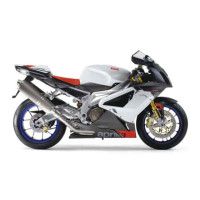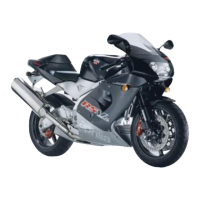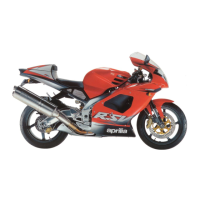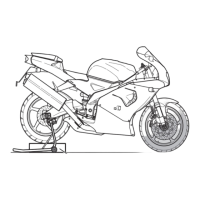91
use and maintenance RSV 1000 R - RSV 1000 R FACTORY
REAR SUSPENSION
The rear suspension is managed by a
spring/damper unit that is connected to the
frame and to the rear swinging arm through
uni-ball bearings and a linkage system,
respectively.
To modify vehicle response, the rear shock
absorber is fitted with an adjusting ring nut
(1) which controls rebound damping, an
adjuster knob (2) which controls
compression damping, an adjusting ring
nut (3) that controls spring preload and a
ring nut (4).
NOTE Vehicle response can be further
modified by varying rear ride height.
REAR SHOCK ABSORBER
ADJUSTMENT
NOTE Halve maintenance intervals if
the vehicle is used in rainy or dusty
conditions, on rough roads or for racing.
Check and if necessary adjust the rear
shock absorber every 20000 km (12500
mi).
Factory setting is designed for racing.
However, rear suspension setting may be
modified to suit specific needs in
accordance with vehicle usage.
CAUTION
Before adjusting, first set the rear shock
absorber to the stiffest setting [turn the
adjusters (1-2) fully clockwise].
Do not force the adjusters (1-2) beyond
their limit stops in either direction, or
the threads may strip.
◆ Release the ring nut (4) by means of the
appropriate spanner.
◆ Adjust spring preload (B) through the
adjusting ring nut (3) (see table).
◆ After adjusting, tighten the ring nut (4).
◆ Work the ring nut (1) to set shock
absorber rebound damping (see table).
Compression damping is adjusted by
turning the knob (2) on models, by
turning the screw (2) on T models (see
table).
To change vehicle trim:
◆ Slacken the lock nut (5) moderately.
◆ Work the adjuster (6) to set shock
absorber length (A) (distance between
centres) (see table).
CAUTION
Tighten the check nut (5) to the
specified torque.
◆ After the adjustment, tighten the lock nut
(5).
Torque wrench setting for lock nut (5):
40 Nm (4 kgm).

